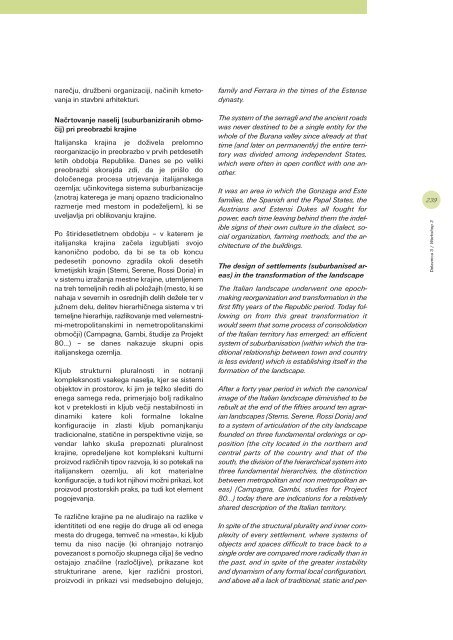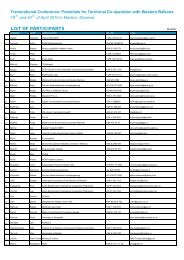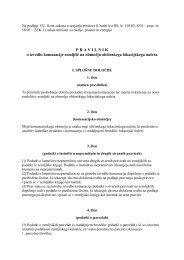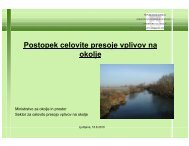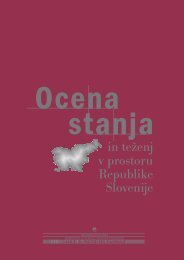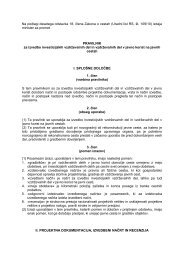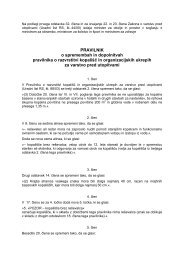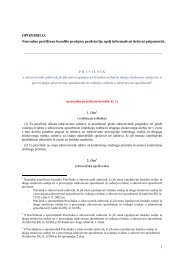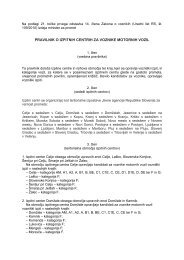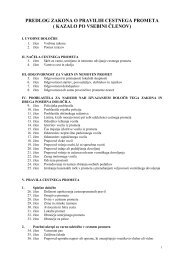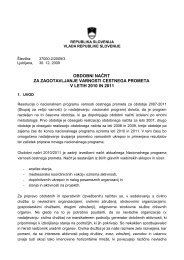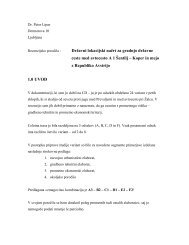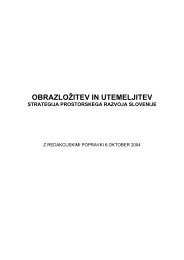evropska konvencija o krajini - Ministrstvo za infrastrukturo in prostor
evropska konvencija o krajini - Ministrstvo za infrastrukturo in prostor
evropska konvencija o krajini - Ministrstvo za infrastrukturo in prostor
You also want an ePaper? Increase the reach of your titles
YUMPU automatically turns print PDFs into web optimized ePapers that Google loves.
narečju, družbeni organi<strong>za</strong>ciji, nač<strong>in</strong>ih kmetovanja<strong>in</strong> stavbni arhitekturi.Načrtovanje naselij (suburbaniziranih območij)pri preobrazbi kraj<strong>in</strong>eItalijanska kraj<strong>in</strong>a je doživela prelomnoreorgani<strong>za</strong>cijo <strong>in</strong> preobrazbo v prvih petdesetihletih obdobja Republike. Danes se po velikipreobrazbi skorajda zdi, da je prišlo dodoločenega procesa utrjevanja italijanskegaozemlja; uč<strong>in</strong>kovitega sistema suburbani<strong>za</strong>cije(znotraj katerega je manj opazno tradicionalnorazmerje med mestom <strong>in</strong> podeželjem), ki seuveljavlja pri oblikovanju kraj<strong>in</strong>e.Po štiridesetletnem obdobju – v katerem jeitalijanska kraj<strong>in</strong>a <strong>za</strong>čela izgubljati svojokanonično podobo, da bi se ta ob koncupedesetih ponovno zgradila okoli desetihkmetijskih kraj<strong>in</strong> (Stemi, Serene, Rossi Doria) <strong>in</strong>v sistemu izražanja mestne kraj<strong>in</strong>e, utemljenemna treh temeljnih redih ali položajih (mesto, ki senahaja v severnih <strong>in</strong> osrednjih delih dežele ter vjužnem delu, delitev hierarhičnega sistema v tritemeljne hierarhije, razlikovanje med velemestnimi-metropolitanskimi<strong>in</strong> nemetropolitanskimiobmočji) (Campagna, Gambi, študije <strong>za</strong> Projekt80...) – se danes nakazuje skupni opisitalijanskega ozemlja.Kljub strukturni pluralnosti <strong>in</strong> notranjikompleksnosti vsakega naselja, kjer se sistemiobjektov <strong>in</strong> <strong>prostor</strong>ov, ki jim je težko slediti doenega samega reda, primerjajo bolj radikalnokot v preteklosti <strong>in</strong> kljub večji nestabilnosti <strong>in</strong>d<strong>in</strong>amiki katere koli formalne lokalnekonfiguracije <strong>in</strong> zlasti kljub pomanjkanjutradicionalne, statične <strong>in</strong> perspektivne vizije, sevendar lahko skuša prepoznati pluralnostkraj<strong>in</strong>e, opredeljene kot kompleksni kulturniproizvod različnih tipov razvoja, ki so potekali naitalijanskem ozemlju, ali kot materialnekonfiguracije, a tudi kot njihovi možni prikazi, kotproizvod <strong>prostor</strong>skih praks, pa tudi kot elementpogojevanja.Te različne kraj<strong>in</strong>e pa ne aludirajo na razlike videntititeti od ene regije do druge ali od enegamesta do drugega, temveč na »mesta«, ki kljubtemu da niso nacije (ki ohranjajo notranjopove<strong>za</strong>nost s pomočjo skupnega cilja) še vednoostajajo značilne (razločljive), prika<strong>za</strong>ne kotstrukturirane arene, kjer različni <strong>prostor</strong>i,proizvodi <strong>in</strong> prikazi vsi medsebojno delujejo,family and Ferrara <strong>in</strong> the times of the Estensedynasty.The system of the serragli and the ancient roadswas never dest<strong>in</strong>ed to be a s<strong>in</strong>gle entity for thewhole of the Burana valley s<strong>in</strong>ce already at thattime (and later on permanently) the entire territorywas divided among <strong>in</strong>dependent States,which were often <strong>in</strong> open conflict with one another.It was an area <strong>in</strong> which the Gon<strong>za</strong>ga and Estefamilies, the Spanish and the Papal States, theAustrians and Estensi Dukes all fought forpower, each time leav<strong>in</strong>g beh<strong>in</strong>d them the <strong>in</strong>deliblesigns of their own culture <strong>in</strong> the dialect, socialorgani<strong>za</strong>tion, farm<strong>in</strong>g methods, and the architectureof the build<strong>in</strong>gs.The design of settlements (suburbanised areas)<strong>in</strong> the transformation of the landscapeThe Italian landscape underwent one epochmak<strong>in</strong>greorgani<strong>za</strong>tion and transformation <strong>in</strong> thefirst fifty years of the Republic period. Today follow<strong>in</strong>gon from this great transformation itwould seem that some process of consolidationof the Italian territory has emerged; an efficientsystem of suburbanisation (with<strong>in</strong> which the traditionalrelationship between town and countryis less evident) which is establish<strong>in</strong>g itself <strong>in</strong> theformation of the landscape.After a forty year period <strong>in</strong> which the canonicalimage of the Italian landscape dim<strong>in</strong>ished to berebuilt at the end of the fifties around ten agrarianlandscapes (Stems, Serene, Rossi Doria) andto a system of articulation of the city landscapefounded on three fundamental order<strong>in</strong>gs or opposition(the city located <strong>in</strong> the northern andcentral parts of the country and that of thesouth, the division of the hierarchical system <strong>in</strong>tothree fundamental hierarchies, the dist<strong>in</strong>ctionbetween metropolitan and non metropolitan areas)(Campagna, Gambi, studies for Project80…) today there are <strong>in</strong>dications for a relativelyshared description of the Italian territory.In spite of the structural plurality and <strong>in</strong>ner complexityof every settlement, where systems ofobjects and spaces difficult to trace back to as<strong>in</strong>gle order are compared more radically than <strong>in</strong>the past, and <strong>in</strong> spite of the greater <strong>in</strong>stabilityand dynamism of any formal local configuration,and above all a lack of traditional, static and per-239Delavnica 3 / Workshop 3


